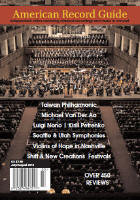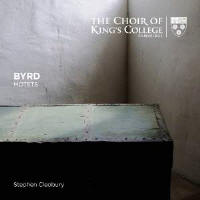Texte paru dans: / Appeared in: |
|
|
Outil de traduction ~ (Très approximatif) |
|
|
Reviewer: William
J. Gatens This program of motets by William Byrd is organized according to seasons and holy days of the church year: Advent, Candlemas, Lent, Easter, Ascension, Whitsun, Trinity, Corpus Christi, All Saints, and feasts of the Blessed Virgin Mary. It is hardly surprising that most of the selections come from the two volumes of Gradualia (1605 and 1607), containing polyphonic settings of Mass Propers as well as some items for the Office, and therefore closely tied to the ecclesiastical calendar. Other works on the program come from the Cantiones of 1575, produced in collaboration with Thomas Tallis, and Byrd’s two volumes of Cantiones Sacrae (1589 and 1591). It appears that the texts for these collections were freely chosen for stand-alone pieces without explicit liturgical function.
The motets recorded here are: Rorate Coeli (G1) Vigilate (CS 1589) Hodie Beata Virgo Maria (G1) Alleluia. Senex Puerum Portabat (G1) Ne Irascaris, Domine/Civitas Sancti Tui (CS 1589) Terra Tremuit (G2) Haec Dies (CS 1591) Tollite Portas (G1) Alleluia. Ascendit Deus. Dominus in Sina (G2) Factus Est Repente (G2) Non Vos Relinquam Orphanos (G2) O Lux Beata Trinitas (C 1575) Laudibus in Sanctis (CS 1591) Ave Verum Corpus (G1) Sacerdotes Domini (G1) Iustorum Animae (G1) O Quam Gloriosum (CS 1589) Ave Maria (G1)
The choir of King’s College, Cambridge, has long been one of the pre-eminent English choral foundations, especially noted for sheer beauty of tone and superlative choral discipline. Given the choir’s reputation, the performances here are disappointing. The technical standard is high, but I cannot describe the tone as warm or the performances ingratiating. It sounds to me as if the vocalists are singing flat out most of the time with very little sensitivity to phrase. Even without artificially imposed dynamic shadings, phrases have eginnings, middles, and ends; and that will come across in performances where the participants are trained to be sensitive to such things. How much of this is owing to the performances themselves and how much to the way were recorded, I am not prepared to say. The sumptuous acoustic of King’s College chapel does nothing to clarify the part writing, and the combination of that with the somewhat aggressive delivery produces a jumble of sound where the counterpoint is intricate. I found it wearying to the ear.
Recordings of the Byrd motets fall into two broad categories: ones sung by full choirs and ones by chamber ensembles, often with one voice to a part. Among other recordings of this sort, I keep coming back to the three discs of generous selections from the Cantiones sung by the choir of New College, Oxford, under the direction of Edward Higginbottom, issued by CRD in 1983, 1986, and 1996. Their most recent reissue was a 3CD set in 2001. In contrast with the present recording, the New College performances are warm and engaging, with meticulous shaping and nuance. Another choral recording worthy of note is Byrd motets from James Lancelot and the choir of Durham Cathedral (Priory 801; July/Aug 2004). While the tone and discipline are excellent, the reverberant acoustic tends to obscure the part writing as at King’s. Byrd’s motets are foundational choral repertory, but the Latin sacred vocal works (Gradualia and three Masses) were written for clandestine Catholic celebrations at places like the country estate of Sir William Petre near Byrd’s home in Essex. The volumes of Cantiones were probably intended for domestic use, and the laments that are so conspicuous in their contents would have been understood as thinly coded commentaries on the plight of English Catholics at the time. Performances that treat these as vocal chamber works probably come closer to what the composer expected. The most comprehensive
recordings are the 13 discs of
the Byrd Edition by Andrew Carwood and The Cardinall’s Musick. The series
began on ASV and concluded on Hyperion (Vol. 13: Hyperion 67779; M/J 2010).
The performances are outstanding technically, but I find them less than
engaging. While not exactly dispassionate, they have something of a
take-it-or-leave-it feel. In contrast, I was bowled over by the expressive
warmth of a one-voice-to-a-part recording drawn mainly from the second
volume of Gradualia by Michael Noone and Ensemble Plus Ultra (Musica Omnia
302; J/F 2011). | |
|
|
|
|
Cliquez l'un ou l'autre
bouton pour découvrir bien d'autres critiques de CD |
|




